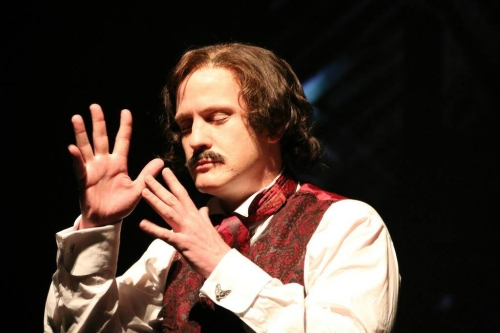Synopsis
 The play begins with Poe pouring a drink. Drinking is a reoccurring theme throughout but we never really make the full conclusion he is an alcoholic. The play is formed around letters that Poe wrote to his wife Virginia and other members of his family. These are chosen and edited to link into a chosen story of Poe’s. The play begins with Poe pouring a drink. Drinking is a reoccurring theme throughout but we never really make the full conclusion he is an alcoholic. The play is formed around letters that Poe wrote to his wife Virginia and other members of his family. These are chosen and edited to link into a chosen story of Poe’s.
Bit by bit his characters come to life around him and he begins to interact with them, slowly at first but more and more frequently as the play goes on; signalling his ailing mind.
We get a glimpse into the life he lived with Virginia and we see that even though they are married, he has a ‘sisterly ‘love for her; bearing in mind they were cousins. This eventually leads us to her untimely death. This breaks Poe and he is finally severed from reality and it is here that he writes ‘The Raven’ given the idea by a small girl; the symbol of Virginia’s innocence and a reminder that their marriage was childless.
The stories are also chosen to reflect certain moods Poe was feeling at the time of his letters. The stories show, bereavement, a fear of death, and also some light-hearted moments when Poe is faced the delightful tale of the town of ‘Vondervotteimittis.’ Here he must listen to bells and chimes while suffering a seemingly never-ending hangover.
We venture also to the realms of The Tell Tale Heart, the story of an old man murdered for no reason other than he is blind in one eye. This is a symbolic tale of Poe’s own feelings towards his adoptive father, who time after time refuses to borrow him money to relive his debts.
The play ends where it began, with Poe pouring a drink. The play itself is a roundabout, and he ends up in exactly the same position, doing exactly the same the thing at the end as he did at the beginning. He has to relive the entire latter part of his life over and over – is he really even there? Is he stuck in purgatory, reliving the more painful memories of his life? That is for the audience to decide.
|
 Loading... Please wait...
Loading... Please wait... Loading... Please wait...
Loading... Please wait...